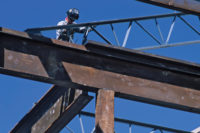
Classroom training alone doesn’t cut it for fall protection. This is a drop test trailer for practical training.
Year after year, falls continue to hold the dubious distinction of the most frequent cause of fatalities at construction sites. Why?
Fall protection equipment manufacturers, contractors and construction workers all share the responsibility. Reliable equipment in the hands of trained personnel is a big part of the solution.
Determine the application
As manufacturers, we are listening better. All reputable manufactures of fall protection devices are in ongoing discussions with end-users. It’s critical that we ask the right questions.
I recall a situation many years ago: We sold some 5/8-inch cable to a customer and later learned that it was undersized for the job, resulting in a failure and a fatality. Had we asked more questions at the order desk, the tragedy would not have happened. I have become a fanatic, insisting that our people ask about application before completing an order. Then and only then, we take what we hear to our engineers and make sure our products meet the need, are user-friendly and are OSHA compliant.
All fall protection products are “friendlier” today. Webbing is soft and pliable, stretch fabrics are available and harnesses come in full-vest configurations. Hardware is lightweight, closure designs offer simple and quick operation.
Killer fashion
A safety director friend and I joke that if you give workers a choice between looking like Clark Kent or the Terminator, they’ll choose the Terminator every time. Colors and fabric influence a worker’s perception of the harness and his attitude toward wearing it.
If it looks good and is comfortable, construction workers will put it on. Next comes training. I’ve seen people fall wearing highly fashionable harnesses. Unfortunately, they were wearing them improperly or had tied off incorrectly.
OSHA requirements
§29 CFR part 1926.21, the OSHA standard for the construction industry, requires training:
- General requirements — the standard calls for the establishment and supervision of “programs for the education and training of employers and employees in the recognition, avoidance and prevention of unsafe conditions and employments covered” by the Occupational Safety and Health Act.
- Employer responsibility — The employer shall instruct each employee in the recognition and avoidance of unsafe conditions and the regulations applicable to his work environment to control or eliminate any hazards for other exposure to illness or injury. Subpart M — Fall Protection states in part §1926.503, training requirements, that the following training provisions supplement and clarify the requirements of §1926.21:
- Training program — The employer shall provide a training program for each employee who might be exposed to fall hazards. The program shall enable each employee to recognize the hazards of falling and shall train each employee in the procedures to be followed in order to minimize these hazards. The employer shall assure that each employee has been trained, as necessary, by a competent, qualified person.
- Certification of training — The employer shall verify compliance by preparing a written certification record, which shall contain the name or other identity of the employee trained, the date of the training, and the signature of the person who conducted the training or the employer. The latest training certification shall be maintained.
- Retraining — When the employer has reason to believe that any affected employee who has already been trained does not have the understanding and skill required under “training program,” the employer shall retrain each such employee. Circumstances where retraining is required include changes in the workplace that render previous training obsolete and changes in the types of fall protection systems or equipment to be used.
Should a fall incident occur at your workplace and OSHA investigates, will you be able to respond affirmatively when the investigator asks the all-important training question? Will you be able to demonstrate that the injured worker had completed the required training?
I have been involved in training throughout the country in fall protection with drop test trailers for many years now. Simply reciting the do’s and don’ts in the classroom doesn’t cut it. We must talk about these case histories, which result in growing injuries, amputations and even death.
Let’s work together to knock “falls on a construction site” from its lofty position as a leading cause of death and injury.


